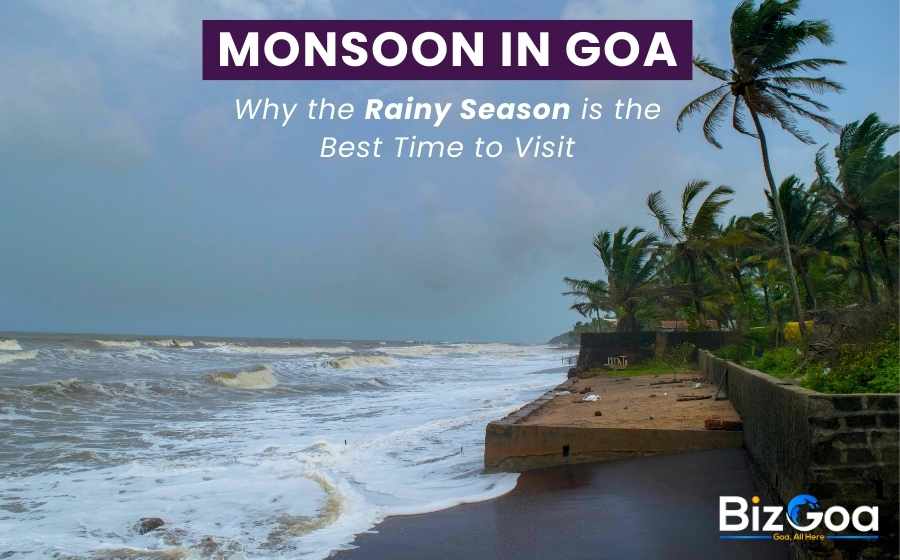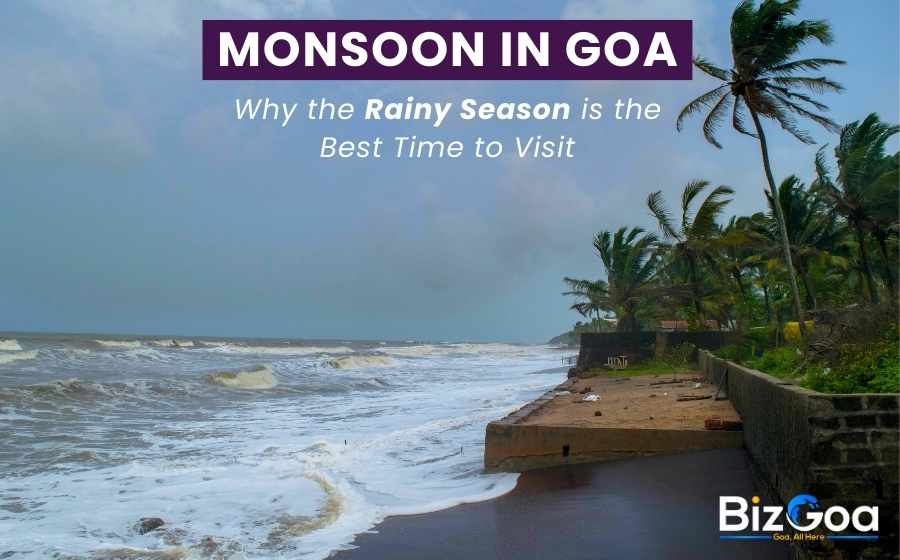- Admin
- Jun 19, 2025
- Travell & Tourism
Monsoon in Goa: Why the Rainy Season Is Perfect for Visit
We are used to Goa as a beach party destination, particularly during winter. But the monsoon reverses the picture. Picture misty mornings, the sound of waterfalls, and deserted roads bordered with rain-fed trees. If serene travelling is your notion of joy, this month enables you to enjoy a gentle, natural Goa.
The Goa monsoon persists from June to September. Rain arrives with the southwest monsoon winds. Showers are a strenuous but short duration, followed by cold winds and sun. There's the fragrance of wet vegetation and soil in the air. The entire state is refreshed. It's the time when Goa's natural beauty is fully in the limelight. Monsoon weather is between 24°C and 30°C. It is warm enough to go out for a walk during the day, but it becomes cool in the evening. That's ideal for walking, trekking, and driving. You'll need to pack light clothes and maybe a light sweater at night.
What the Monsoon Season Is Like in Goa
July is the month when Goa gets most of its rain. It gets the most regular and heavy showers. But it won't tend to rain the whole day. You will mostly get a couple of heavy showers and then some hours of clear or cloudy weather. It is advisable to be adaptable with itineraries and indulge in a rainy rhythm. It is hot and humid this season. Travel light, quick-drying clothes. Denim takes forever to dry. Water-friendly shoes or sandals are a big help while walking. An umbrella can never match a good raincoat on windy days.
-
Goa monsoon falls between June and September.
-
Rain is in brief, heavy showers with pleasant intervals.
-
Temperatures are between 24°C and 30°C.
-
The month of July is the wettest month of the season.
-
Wear light, drying clothing and water shoes.
-
Swimming is not safe, but beaches are still a good place to go.
The sea is usually too rough for swimming. Lifeguards often ask visitors to stay out of the water for safety. Even though you can’t enter water activities, beaches are still beautiful for walks and photos. Watching the monsoon waves crash onto the shore is a whole experience in itself.
Best Things to Do in Goa During the Rainy Season
Even if the rain seems unpredictable, there’s still plenty to do. In fact, some activities are even better during this time. Whether you like nature, food, or culture, the monsoon adds something extra to every experience. You just have to know where to look.
|
Activity |
Description |
Tips |
|
Waterfalls |
Dudhsagar, Tambdi Surla, and Netravali look stunning with strong water flow and green forests. |
Wear good shoes and check the weather first. |
|
Spice Plantations |
Guided tours in Ponda show spice growth and end with a traditional Goan meal. |
Enjoy the fresh rain and spice aromas. |
|
Monsoon Treks |
Trails in Mollem and Cabo de Rama are quiet, green, and misty. |
Hire a local guide if you are new to trekking. |
|
Café Hopping |
Cosy cafés like Baba au Rhum and Artjuna offer indoor seating and views of the rain. |
Great for reading, writing, or relaxing. |
|
Goan Food |
Hot dishes like fish curry, vindaloo, and sweet patoleo are especially tasty. |
Try local thalis and home-cooked meals. |
|
Heritage Sites |
Portuguese forts, churches, and Fontainhas look charming and peaceful in the rain. |
Explore slowly to enjoy the calm mood. |
|
Birdwatching |
Sanctuaries like Bondla and Salim Ali are active with nesting and migrating birds. |
Bring binoculars and be patient. |
|
Local Festivals |
Festivals such as São João and Chikal Kalo offer music, energy, and local traditions. |
Attend to experience authentic culture. |
Best Places to Visit in Goa During Monsoon
While some places slow down, others come alive with the rains. You will find another Goa when you move away from the usual beach roads. These are the places that sparkle in the monsoon.
-
Dudhsagar Falls is amongst the highest waterfalls in India and thunders at this time. The jeep drive or trek to reach here can be slightly problematic, but worth every attempt. There is a mist around the falls, and the jungle appears to be virgin. A must-visit under favourable weather.
-
Fontainhas, the Latin Quarter in Panaji, is full of charm and colour. The rain makes the cobbled streets shine and adds a quiet atmosphere to the heritage buildings. It’s great for photography, café stops, and casual walks. You’ll feel like you’re in a small European town.
-
Chorla Ghats in the Western Ghats' northern region provide misty forests, scenic roads, and some of the best scenery in Goa. It's just stunning with clouds floating into valleys. It's a good day trip if you're a nature lover. Lunch with a view at an eco-resort.
-
Spice plantations such as Sahakari or Savoi are green and verdant today. You walk through plantations with guides describing how the spices grow and are harvested. It is a calming and sensual experience. And the food that you eat here is also frequently some of the most authentic that you will get.
-
The cinematic sea views are offered by Chapora Fort, and it's a whole different story in the rains. The climb is slightly slippery, but it's worth the trouble. Way down below the waves are crashing, and brooding clouds cover you. Take your camera and stroll at your leisure.
-
Bhagwan Mahavir Wildlife Sanctuary is a treasure trove for a nature lover and trekker. The forest is full of life, and the small streams run along the trail. You have a view of deer, monkeys, or shy birds. It is one of the most verdant places to be in Goa during rainy days.
-
Divar Island is serene and picturesque, accessed by ferry alone. Rain turns its fields and its meandering streets more lovely. You may walk or bike, going to minute churches and bakeries. It's reversing the clock.
-
South Goa's Galgibaga and Kakolem secret beaches are peaceful and virtually uninhabited. You can't swim, but they are perfect for a stroll and some thought. The view is untamed and breathtaking. You won't see another human being in the whole length of time you occupy it.
Tips for Monsoon Travel in Goa
-
Pack light, quick-drying clothes to stay comfortable in humid weather.
-
Carry a good rain jacket or poncho instead of relying on an umbrella.
-
Wear waterproof, non-slip shoes for safer walking on wet roads.
-
Use a waterproof pouch to protect your phone and valuables.
-
Bring mosquito repellent and basic medicines for colds or allergies.
-
Choose accommodation with indoor spaces like cafés or balconies.
-
Keep your daily plans flexible in case of unexpected rain.
-
Avoid swimming or water activities during rough sea conditions.
-
Rent a car or pre-book cabs instead of riding a scooter.
-
Download offline maps and weather apps for easy navigation.
Goa Monsoon Itinerary by Traveller Type
|
Day |
Solo Travelers |
Couples |
Families |
Nature Lovers |
|
1 |
Check in, explore Fontainhas Café hop, read or journal |
Check in, sunset walk at Miramar |
Check in, beach walk at Candolim |
Explore Fontainhas, riverside walk |
|
Dinner at a romantic indoor restaurant |
Dinner at a family-friendly Goan restaurant |
Enjoy a riverside dinner and early rest |
||
|
2 |
Trek to Tambdi Surla + wildlife sanctuary Lunch at Sahakari Spice Farm |
Visit Dudhsagar Falls + spice plantation |
Dudhsagar trip with jeep safari |
Full-day trek to Dudhsagar, birdwatching |
|
Spa session in the evening |
Kids-friendly dinner, games night |
Nature lodge stay or retreat |
||
|
3 |
Visit Anjuna flea market + cafés |
Breakfast in bed, explore Chapora Fort |
Visit old Goa churches, and local sweets |
Visit Salim Ali Bird Sanctuary |
|
Sunset at a quiet beach like Ashwem |
Sunset walk, feni tasting |
Art class or indoor play café |
Forest photography walk |
|
|
4 |
Day trip to Divar Island by ferry |
Drive to Chorla Ghats + eco-lunch |
Visit Ponda spice plantation + elephant visit |
Trek in Mollem, explore hidden waterfalls |
|
Explore on a rented scooter |
Candlelit dinner during the rain |
Movie night or storytime indoors |
Campfire or lodge dinner with locals |
|
|
5 |
Morning market, buy spices & souvenirs |
Late breakfast, couples spa session |
Pack, souvenir shopping, easy lunch |
Visit the last waterfall or trek spot |
| 6 |
Slow beach walk before departure |
Slow walk, coffee, and fly back |
Fly or drive home relaxed |
Return from trek, head to the airport |
Conclusion
Monsoon tourism in Goa is an escape from the stereotypical beach party scene. Rains reveal the serene, green face of the state, perfect for nature lovers, couples, and seekers of peace vacations. From forest waterfalls and scenic pathways to rugged cafes and promenades along heritage roads, there is plenty to be found even on gloomy days. Fewer visitors, fantastic bargains, and plenty of local experiences, the monsoon is one of the state's best-kept secrets. Just dress up decently, be willing to change your plans at a moment's notice, and soak up the beat of the rain. Goa monsoon could be the best thing that has ever occurred to you.
Read our latest blog to discover secret spots most tourists miss.
And don’t forget to visit BizGoa for local updates, events, and insider tips.
FAQs
1. Is it safe to travel to Goa during the monsoon?
Yes, it is safe to travel to Goa during the monsoon. Although the sea will be rough and swimming is not advisable, land activities such as trekking, visiting spice farms, and heritage sites are safe and fun, provided with necessary caution.
2. Are beaches closed during the monsoon season?
Beaches are open, but swimming and water sports are mostly forbidden because of high tides and currents. Beach walking, photography, and seaside eateries remain permissible.
3. What do I bring on a monsoon vacation in Goa?
Light drying clothes, waterproof shoes or sandals, a raincoat, insect repellent, and a water-resistant backpack to protect electronics from water. Do not wear jeans or slow-drying clothes.
4. Are restaurants and hotels open in the monsoon?
Yes, all hotels, resorts, and restaurants are open throughout the year. Also, monsoon deals are prevalent, and a majority of the properties have wonderful indoors such as lounges and balconies where one can relax and watch the rain.
5. Is it easy to travel around Goa in the monsoon?
Scooters are not advisable because of slippery roads. Hiring a car or advance booking of taxis is safer and more convenient, particularly if you plan to visit offbeat or hill tracks.




Leave a Comment